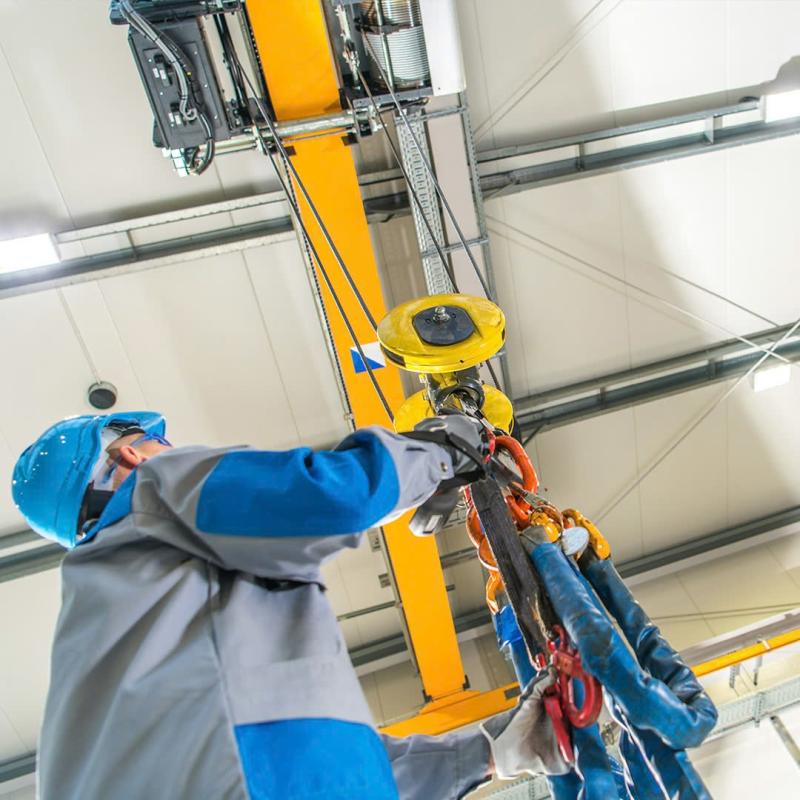



But with alternatives like gantry cranes, davit arms, and overhead hoists also available, how do you determine which system is the right fit for your operation?
This article will guide you through a comparison between jib cranes and their common alternatives, analyzing applications, benefits, and limitations—so you can make an informed purchasing decision based on your workspace, budget, and operational goals.
To explore specialized models, visit The specification of Jib Cranes
Jib cranes are lifting devices consisting of a horizontal jib or boom that supports a hoist, which is fixed to a wall or floor-mounted vertical mast. They are ideal for repetitive, localized lifting in manufacturing cells, warehouses, or near assembly lines.
Learn more at Manufacturing Jib Crane
Freestanding Jib Crane – Mounted on the floor, offering 360° rotation.
Wall Mounted Jib Crane – Attached to structural walls, ideal for compact spaces.
Ceiling Mounted Jib Crane – Suspended from ceilings, saving valuable floor area.
Articulating Jib Crane – With dual arms for maneuvering around obstacles.
Pillar Jib Crane – Heavy-duty versions mounted on steel columns.
Use Case: Gantry cranes are mobile and can span larger areas, suitable for moving heavy loads across distances. Jib cranes, in contrast, are best for repetitive lifting in defined work zones.
Installation: Gantry cranes require a flat surface but no permanent installation. Jib cranes (especially freestanding and wall-mounted) need bolting or welding into place.
Mobility: Gantry cranes can be moved throughout a facility. Jib cranes are fixed.
Cost: Jib cranes are more cost-effective for workstations. Gantry cranes tend to be more expensive but offer greater range.
Explore more on Jib Crane comparison
Davit Arm: Often used for small-scale or rooftop applications. Limited in load capacity and arc range.
Jib Crane: Handles higher capacities with broader coverage and is more rugged for industrial use.
Safety: Jib cranes have standardized load ratings and are engineered for consistency. Davit arms are sometimes DIY or temporary.
Overhead Crane: Covers large factory spaces with tracks mounted on building girders.
Jib Crane: More economical for spot-lifting at specific stations.
Flexibility: Jib cranes can be installed independently of building structure.
View the full installation details in this Step by step guide to install a jib crane
A facility in Victoria installed the Wall-mounted Jib Cranes in Industry to lift metal sheets onto cutting tables. With 180° rotation and a 250kg capacity, handling time was reduced by 30%.
At a plant in Melbourne, operators used the Articulated jib cranes wall-mounted to install engine blocks into vehicles. The articulated design allowed precise placement despite tight layouts.
A plastics facility in NSW opted for a pillar jib crane mounted centrally in their mold zone. It enabled fast, safe lifting of heavy tooling with reduced downtime.
You should consider a jib crane over gantry cranes or hoists if:
The lifting task is repetitive and localized
Space is constrained or walls are load-bearing
You require ergonomic lifting with limited operator fatigue
You need to avoid ceiling rail installations
| Feature | Jib Cranes | Gantry Cranes | Davit Arms |
|---|---|---|---|
| Load Capacity | Up to 2,000kg (model dependent) | Up to 5,000kg | 100–500kg |
| Rotation Range | 180°–360° | 180° (manual) | 180° or fixed |
| Installation Type | Floor/Wall/Ceiling Mount | Floor Rolling | Fixed or mobile |
| Common Use | Workstations, assembly lines | Heavy material transport | Light-duty vertical lifts |
Installation Costs: Wall-mounted units are more economical than freestanding versions.
Customization: Arm length, hoist type, and material finishes affect pricing.
Aardwolf’s Value: Aardwolf offers a wide selection of competitively priced, engineered jib cranes.
Choose Jib Cranes for fixed, repetitive tasks in defined work zones.
Choose Gantry Cranes for flexibility and wide-area lifting needs.
Choose Davit Arms for compact, low-capacity lifting (e.g., rooftop equipment handling).
For product selection assistance, visit The specification of Jib Cranes
References
1. How to operate a Jib Cranes safely
3. Over brace jib crane wall mounted
5. Is a Jib Crane a Gantry Crane
6. Articulated Jib Crane Wall Mounted
8. Manual Counterbalance Crane
10. Over Braced Jib Crane Column Mounted
Sign up to receive the latest info on new Aardwolf products, special offers and more.
By signing up you agree to receive emails from Aardwolf with news, special offers, promotions and other information. You can unsubscribe at any time.